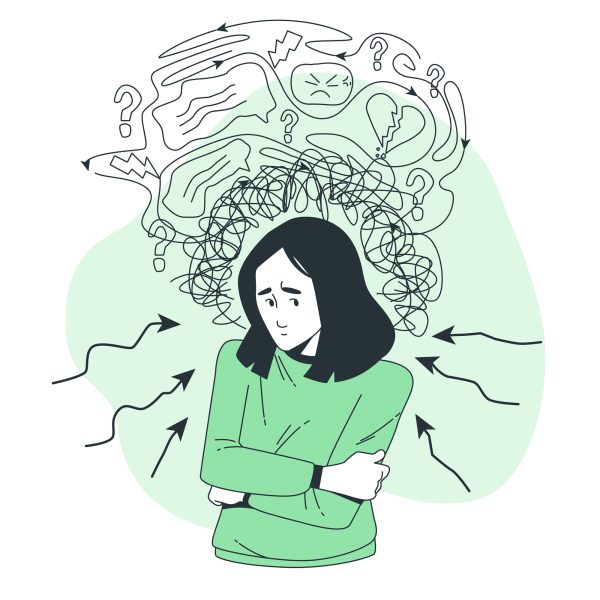Maintaining good mental health is crucial for overall well-being, enabling individuals to function effectively in various aspects of life, including personal relationships, academic pursuits, and professional endeavors. Mental health is defined by where individuals find peace with themselves, can cope with life’s stresses, work productively, and contribute to their environment (MHF, 2008).
Mental disorders can arise from poor mental health. People with mental disorders are more at risk of self-harm. Self-harm, also known as non-suicidal self-injury (NSSI), is an intentional act of inflicting pain upon oneself, typically without suicidal intent (Klonsky & Muehlenkamp, 2006).
Self-harm is often used as a coping mechanism to manage overwhelming emotions such as anxiety, depression, anger, or sadness, but you have to remember that it is not a conscious choice but a manifestation of underlying emotional turmoil. Understanding, support, and effective coping strategies are essential for overcoming this behavior.
So, what can I do to cope and prevent self-harm? There are many ways you can do this. Overcoming self-harm requires a comprehensive approach that addresses both the underlying emotional distress and the behavior itself.
External factors like a strong support system, positive future outlook, and optimism play a crucial role, but internal strategies like shifting focus through mindfulness, engagement, and creative expression can also directly address the intrusiveness of self-harm thoughts.
To put this into action, you can engage in enjoyable hobbies, meditate, and engage in other activities that can divert your attention. Equally important to internal focus management are external factors such as avoiding triggers and establishing healthy boundaries.
Avoid being confined to a situation where you could feel under pressure to damage yourself. You need to have the guts to break off social connections with people who are bad for your mental health in order to create a pleasant environment.
Remember that maintaining control over your surroundings-even when it requires making tough choices-is essential to your wellbeing. Accept the inner fortitude to create an environment that supports your recovery.
It is evident from what is discussed in this text that self-harm is a complicated problem that results from severe mental suffering. Learning effective internal coping mechanisms is just as important for breaking this pattern as learning external ones, such as an optimistic mindset and a network of supportive people.
We now have a variety of tools at our disposal thanks to this guidance, including constructive activities and appropriate boundary-setting. Knowing the importance of both external and internal elements will enable us to prioritize our own well-being and overcome the obstacles of self-harm.
Keep in mind that controlling your surroundings and strengthening your resilience are essential components of creating a life that is peaceful and fulfilling. Accept the path of self-discovery and healing, and keep in mind that you are not going through this alone.
The path to recovery may be tough and challenging, but there’s nothing wrong with trying to stop hurting yourself and start trying to love yourself.
Author: Zahra Yumna Tsabita Anwar
Psychology Student, Universitas Pendidikan Indonesia
Editor: Salwa Alifah Yusrina
Bahasa: Rahmat Al Kafi
References
Brennan, C. A., Crosby, H., Sass, C., Farley, K. L., Bryant, L. D., Rodriquez-Lopez, R., Romeu, D., Mitchell, E., House, A. O., Guthrie, E. (2023) What helps people to reduce or stop self-harm? A systematic review and meta-synthesis of first-hand accounts. Journal of Public Health, Volume 45, Issue 1, March 2023, Pages 154–161, https://doi.org/10.1093/pubmed/fdac022
Bhattacharyya, D., Namdeo, M., & Dwivedi, A. K. (2018). Proactive coping style and intentional self-harm: A cross-sectional study. Industrial psychiatry journal, 27(1), 67–72. https://doi.org/10.4103/ipj.ipj_2_18
McHale, J., & Felton, A. (2010). Self‐harm: what’s the problem? A literature review of the factors affecting attitudes towards self‐harm. Journal of psychiatric and mental health nursing, 17(8), 732-740.
Karp, M.-C., Mazzone, D., & Hadlaczky, K. (2018). Association Between Nonsuicidal Self-Injury and Suicidal Ideation: A Meta-Analysis. JAMA Psychiatry, 75(6), 583-590.
Bhugra, D., Till, A., & Sartorius, N. (2013). What is mental health?. International Journal of Social Psychiatry, 59(1), 3-4.
Ikuti berita terbaru Media Mahasiswa Indonesia di Google News
